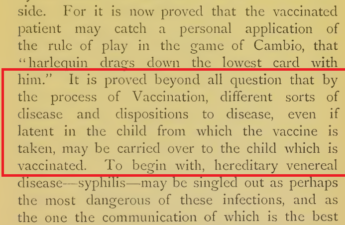
A pillar of the COVID-1984 programming is “Stay Inside.”
The stated purpose is that it is good for you. But it’s generally not — and any health professional worth his salt knows this.
As Knut Wittkowski, a Biostatistician/Epidemiologist who has modeled epidemics for 35 years, notes:
Respiratory disease/the flu ends during Springtime, when people spend more time outdoors, because outdoors the viruses cannot easily spread. That is a form of containement, spending more time outdoors. … [Spending more time indoors] keeps the virus healthy.
Too much time indoors can be detrimental, and when done on a national level, can cause a spike in disease. As Doctor Dan Erickson of Accelerated Urgent Care in Kern County, California notes:
As I shelter in place, my immune system drops. You keep me there for months, and it drops more. And now I’m at home, hand washing vigorously, washing the counters, worried about things that are indeed what I need to survive. …
If someone has a reduced immune system, you hide them away, because they can’t build an immune system. If you have a normal functioning immune system, you need interaction. …
Sheltering in place decreases your immune system. And then as we all come out of shelter in place with a lower immune system and start trading viruses, bacteria—what do you think is going to happen? Disease is going to spike.
In the article “The open-air treatment of pandemic influenza” from the American Journal of Public Health, we see that outdoor treatment was beneficial in treating the Spanish flu in 1918-1919 — contrary to the narrative of today’s over-hyped Coronavirus pandemic.
The article also gives other historical examples of the health benefits of sunlight/being outdoors, as well as benefits to particular conditions.
H1N1 “Spanish flu” outbreak of 1918–1919
In this outbreak, “killing between 50 million and 100 million people,” measures such as “fresh air” and “sunlight” appear “to have substantially reduced deaths among some patients and infections among medical staff.”
The authors discuss in particular Camp Brooks Open Air Hospital at Corey Hill in Brookline, in Massachusetts:
The treatment at Camp Brooks Hospital took place outdoors, with “a maximum of sunshine and of fresh air day and night.” (p1747) The medical officer in charge, Major Thomas F. Harrington, had studied the history of his patients and found that the worst cases of pneumonia came from the parts of ships that were most badly ventilated. …
The patients at Camp Brooks recovered in direct sunlight when available. This may have kept infection rates down, because laboratory experiments have shown that ultraviolet radiation inactivates influenza virus and other viral pathogens and that sunlight kills bacteria. In addition, exposure to the sun’s rays may have aided patients’ recovery, because sunlight is known to promote healing in other conditions such as septic war wounds.
Richard A. Hobday and John W Cason. “The open-air treatment of pandemic influenza.” American journal of public health vol. 99 Suppl 2,Suppl 2 (2009): S236-42. doi:10.2105/AJPH.2008.134627. Retrieved May 9, 2020, from https://www.ncbi.nlm.nih.gov/pmc/articles/PMC4504358
Historical examples in Treating Tuberculosis
By the 1850s, Florence Nightingale (1820–1910) was writing about the importance of sunlight and copious amounts of fresh air in the recovery of hospital patients, but her ideas were slow to gain acceptance. And so it was in Germany that the open-air regimen reemerged, most notably at the Nordrach-Kolonie in the Black Forest, a sanatorium established in 1888 by Otto Walter (1853–1919). It was so well known that “Nordrach” became the term for open-air sanatoria.
By 1908, there were at least 90 of them in Britain, many of which were enthusiastic imitations of Nordrach. An open-air recovery school for tubercular children, founded in 1904 at Charlottenburg, a suburb of Berlin, was the first of its type and, as with Germany’s open-air sanatoria, was widely imitated. In 1884, Edward Livingston Trudeau (1848–1915) opened America’s first sanatorium at Saranac Lake in New York State. The first open-air orthopedic hospital was set up in the Shropshire village of Baschurch in England in 1907. In the two decades before World War I, charitable associations, leagues, and societies dedicated to preventing and eliminating tuberculosis among the poor flourished, as did sanatoria.
Hobday and Cason, “The open-air treatment of pandemic influenza.”
Particular benefits of being outdoors
There is evidence that heart attack victims stand a better chance of recovery if they are in sunlit wards. Depressed psychiatric patients fare better if they get some sun while hospitalized, as do premature babies with jaundice. In one study, patients in hospital wards exposed to an increased intensity of sunlight experienced less perceived stress and less pain and took 22% less analgesic medication per hour. One advantage of placing patients outside in the sun is that they can synthesize vitamin D in their skin, which they cannot do indoors behind glass. Rickets, the classic childhood disease of vitamin D deficiency, has long been associated with respiratory infections; it has been hypothesized that low levels of vitamin D may increase susceptibility to influenza. …
[Influenza might be combated] by introducing high levels of natural ventilation or, indeed, by encouraging the public to spend as much time outdoors as possible.
Hobday and Cason, “The open-air treatment of pandemic influenza.”
Concluding thoughts — being outdoors and God’s natural design
Getting outdoors is healthy. This is a given, when we consider that God created the earth and everything in it. Man was created outdoors and told by God to subdue the earth.
Man is the pinnacle of God’s creation, and God fashioned nature for man’s benefit. It provides air, water, food, sunlight, etc.
Thus, from a biblical worldview it follows that, generally speaking, being outdoors is healthy.
We live in a fallen world, so there are exceptions — harsh weather, severe pollution, etc. But the point should be well taken. When man perpetually hides inside contrary to God’s natural design, we would expect health problems to result, since God created man to be actively interacting with God’s creation.
As history, science and experience teach us, living by God’s design has benefits. Disregarding God’s design has consequences.
If you find this site helpful, please consider supporting our work.


